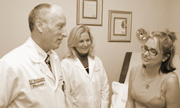 To transition to the adult program, a patient must sign a release of information form for their current pediatric transplant program. Once records are received by Barnes-Jewish, patients are assigned to a physician and a nurse coordinator. For patients transitioning from St. Louis Children's Hospital, members of the adult team will meet the patient and family at their "graduation visit."
To transition to the adult program, a patient must sign a release of information form for their current pediatric transplant program. Once records are received by Barnes-Jewish, patients are assigned to a physician and a nurse coordinator. For patients transitioning from St. Louis Children's Hospital, members of the adult team will meet the patient and family at their "graduation visit."
The first clinic visit
Prior to the first Barnes-Jewish lung transplant clinic visit, patients will receive a schedule and a map of the medical center campus. Lab work, chest x-rays and pulmonary function tests (PFTs) will be done at the first visit. Comprehensive physician and nursing assessment, psychosocial evaluation by social work and nutritional evaluation by the transplant dietitian will be performed over one to two days. It is important to be on time for the appointments and to bring a list of questions and medications.
Follow up care
Patients who live locally have routine office visits, follow up labs, chest x-rays and PFTs every two to three months, depending on their medical condition.
For patients living farther away, the Barnes-Jewish transplant staff fosters a working relationship with the patient's local physician in order to provide the best long-term care. Communication between local physicians and the Barnes-Jewish transplant office is vital and strongly encouraged. Patients can see their local physicians to manage day-to-day non-pulmonary medical problems. For pulmonary issues, the Barnes-Jewish staff will assist patients' local physicians as much as possible; and we will see patients in clinic at Barnes-Jewish every six to 12 months. A patient's immunosuppressive therapy will continue to be monitored and regulated by the adult team staff.
Bronchoscopy
The purpose of a bronchoscopy is to look for rejection and infection. This procedure is done routinely several times during the first year after transplant. After the first year, they are only done when medically indicated. If it is needed, the coordinator and/or physician will discuss further with the patient.